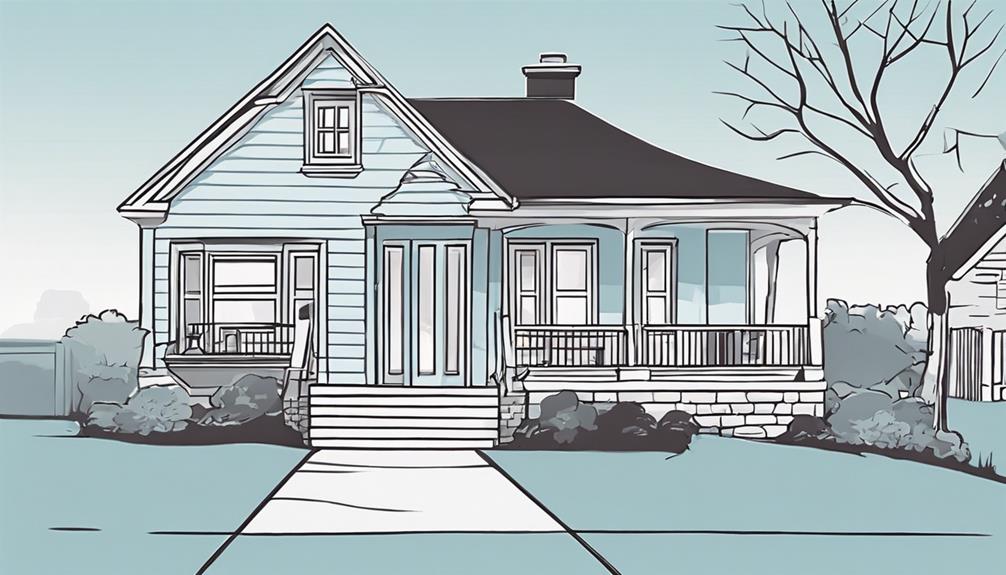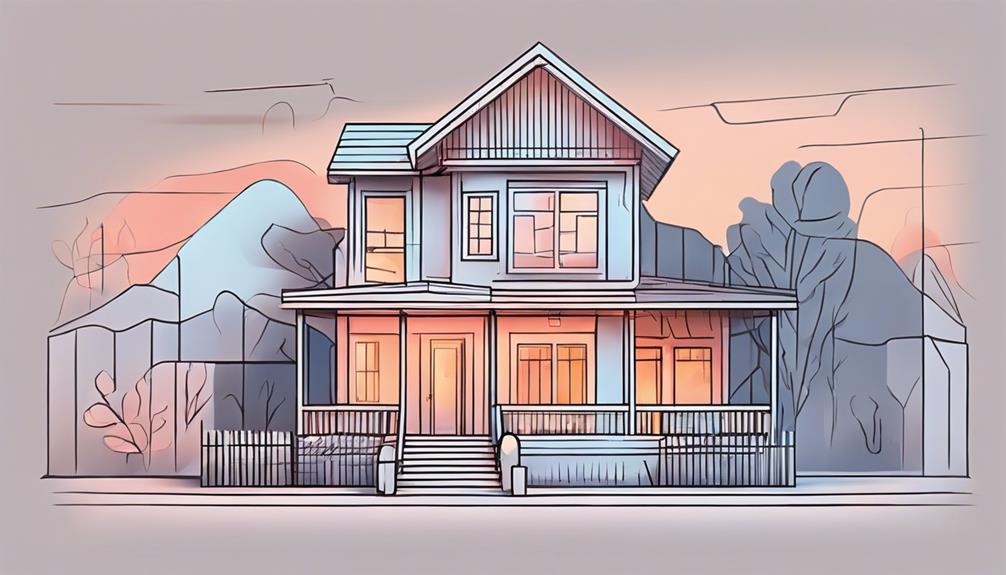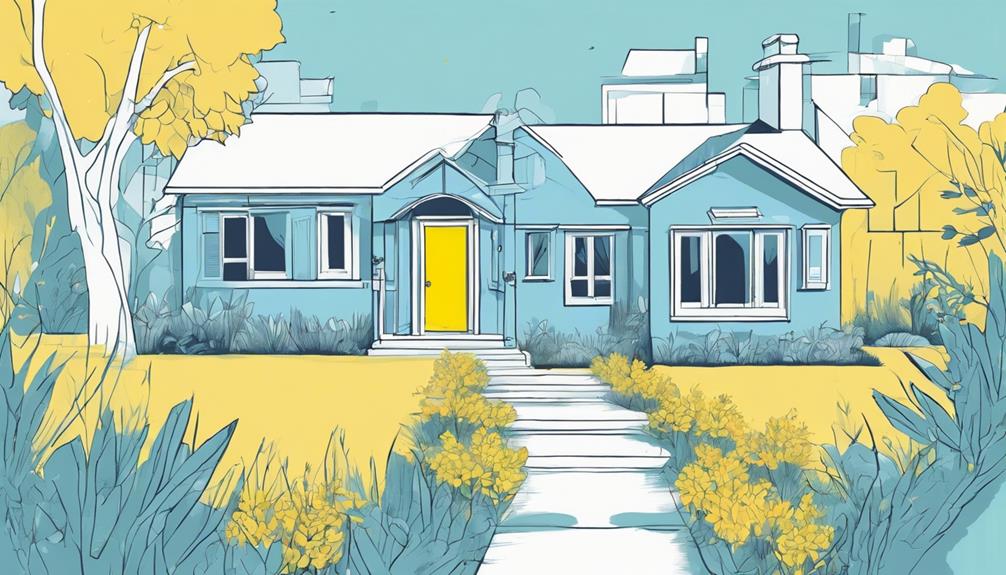Choosing the right exterior color for a small house is crucial. It can help your home attract attention and feel welcoming.
While many options exist, from neutral shades to bold hues, picking the perfect color depends on your house's size, its surroundings, and the style you want.
This choice can make your small house seem more like a cozy, inviting space, highlighting its best features and making it stand out to potential buyers.
Key Takeaways
- Light colors create a spacious feel, ideal for small houses.
- Neutral tones offer a timeless backdrop that enhances the house's appeal.
- Choose accents wisely to add charm and character to the small house.
- Test paint samples in different lighting to find the perfect color that complements the house.
Consider the Size and Style

When choosing the best exterior color for a small house, consider matching the color to the size and style of the house to create a cohesive and visually appealing look. Color psychology plays an important role in how colors can affect the perception of size. Lighter colors like whites, pastels, or soft neutrals can make a small house appear larger, while darker hues can add coziness but may make the house seem smaller.
Architectural guidelines suggest that the color should complement the architectural style of the house. For instance, a Victorian-style house might look best in a more traditional color palette, while a modern-style house could benefit from bold and contemporary colors.
Understanding the historical context of the house can guide color choices. Researching the time period when the house was built can inspire appropriate color selections. However, don't be afraid to incorporate modern trends. Mixing historical charm with a modern twist can create a unique and stylish exterior that stands out in the neighborhood.
Evaluate Natural Surroundings
Consider how the natural surroundings of your small house can influence the choice of exterior color to harmonize with the environment and enhance the overall aesthetic appeal. When evaluating your natural surroundings, take into account how the seasonal color changes can impact the look of your house throughout the year. Additionally, consider local architectural trends to guarantee your small house blends well with the neighborhood.
| Natural Surroundings | Considerations |
|---|---|
| Seasonal color changes | Adapt color accordingly |
| Local architectural trends | Blend with neighborhood |
Opt for Light or Neutral Tones

To achieve a visually spacious and timeless look for your small house, opt for light or neutral tones in the exterior color palette. Light colors like soft grays, creamy whites, or pale blues can make your small house appear larger and more inviting. These hues confirm light, creating an airy and open feel that can enhance the overall aesthetic of your home. Neutral tones such as beige, taupe, or light gray also provide a classic and versatile backdrop for your small house, allowing you to easily update other design elements over time.
While bold colors can make a statement, they may overwhelm the limited space of a small house. Opting for light or neutral tones validates that your home's exterior remains visually appealing without appearing too busy or cramped. Earthy tones, inspired by nature, can also complement the surrounding environment and create a harmonious balance with your small house's exterior. By choosing light or neutral tones, you can achieve a sophisticated and cohesive look that stands the test of time.
Complement With Accents
To enhance the light or neutral tones you've selected for your small house's exterior, consider complementing them with accents that add charm and character to your home's overall appearance. Color psychology plays an important role in choosing the right accent colors. For instance, a pop of a vibrant color like red can evoke feelings of energy and excitement, while a soothing blue can create a sense of calm. Keeping up with current design trends is essential. Earthy tones like terracotta or olive green are popular choices that can give your home a modern yet cozy feel.
When adding accents, think about DIY painting techniques to personalize your home. From painting your front door a bold color to incorporating a two-tone scheme with your trim, there are various ways to make your small house stand out. These accents not only enhance curb appeal but also make your home more inviting. Experimenting with different accent colors can help you find the perfect combination that suits your style and makes your small house a standout in the neighborhood.
Test Samples in Different Lighting

Experiment with painting samples of different colors on your small house's exterior to observe how they look in various lighting conditions. This step is essential as colors can appear differently based on the amount of natural light your house receives throughout the day.
Here are some tips to keep in mind when testing samples in different lighting:
- Color Psychology: Keep in mind the psychological effects of colors. Warm tones like yellow and red can evoke feelings of energy and happiness, while cooler tones like blue and green may create a sense of calmness and tranquility.
- Visual Impact: Keep in mind how each color choice will impact the overall look of your small house. Bold colors can make a statement and add personality, while neutral tones provide a timeless and classic appearance.
- Color Trends: Stay informed about current color trends in exterior house paint, but don't be afraid to go with a color that reflects your personal style and taste.
- Personal Preference: Ultimately, choose a color that resonates with you and complements your home's architecture and surroundings. Your preference plays a significant role in creating a space that feels like home.
Conclusion
Selecting the ideal exterior color for a small house involves careful consideration of its dimensions, architectural style, and the natural landscape it resides within. Light or neutral shades are recommended to visually expand the space, while accent colors add a unique touch.
It's crucial to test these hues under various lighting conditions to ensure their aesthetic appeal is consistent. This approach not only enhances the house's appearance but also invites reflections on how color influences perception and emotion in our living spaces.
Could the right shade transform not just our homes, but also our experience of them?

